INFERENTIAL EVIDENCE FOR THE PRE-TELESCOPIC
SIGHTING OF THE CRESCENT VENUS
David Lance Goines
Berkeley, California, 1992
Version of October 18, 1995
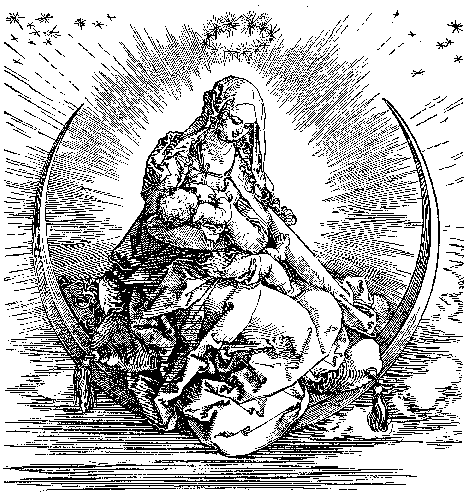
On September 25, 1991, between 6:15 and 6:45am local time in Padua and while traveling to the airport at Venice, Italy, I observed Venus as I have never before seen the planet. In a clear reddish sky, well above the brightening horizon, it appeared as a brilliant, slender thread of light with pronounced radiance's at its two extreme points. Squinting reduced the glare somewhat, and enabled me to see that the planet was something like a crescent, and quite unlike the bright dot of nearby Jupiter. The only other astronomical body visible at the time was the just-past-full Moon near the opposite horizon.
Using the tinted upper part of the windshield of an automobile as a glare-reduction filter, I and two companions clearly saw the planet as a thin crescent. Though I have looked at Venus for better than four decades, and have known for years that it displays Moon-like phases, which I have often observed through a telescope, I have never seen them with the unaided eye.{1}
It had formerly been my understanding that a small percentage of the population can see, or has seen the planet as a crescent, but that this is by no means usual.{2} However, as on this particular occasion all three of us easily saw the planet display its crescent phase, I wonder if it is more commonplace than I had thought. None of us has exceptional vision: I am a Caucasian male, 46 years old and without glasses extremely nearsighted; my companions were a 35-year-old Caucasian man, Luigi Semenzato, also very nearsighted without correction, and a 29-year-old Asian woman, Edie Sei Ichioka, very slightly nearsighted and not wearing her glasses. Sitting in the back seat of the car, Ms Ichioka did not even have the tinted windshield as a filter; nonetheless she saw the crescent quite clearly.
As the sky brightened, we were all three able to see the crescent with no difficulty.
The only special circumstance that surrounded this particular sighting was the large amount of upper atmospheric aerosols (hence the strikingly red skies at sunrise and sunset) from the June 12, 1991 volcanic explosion of Mount Pinatubo.{3}
The one thing which I am not prepared to accept is that I saw something that expert ancient astronomers (or astrologers, as they were in reality) did not see. Here I cite the flip-side of Murphy's Law: "If it did happen, it can happen." They certainly noticed that the planets were different from the other celestial bodies, and understood perfectly well that the religiously exceedingly important "Morning and Evening Star" were one and the same.{4} These guys were no dummies, and it seems to me that if even one of them had noticed that Venus was in any way different from its companions, further scrutiny would have been inevitable. The puzzle thus becomes, if they saw it as a crescent, why didn't they say anything about it?{5}
Of course, if you already know that something looks a certain way, it is a lot easier to see it that way.{6} I'll admit that the presence of a slight filter helped, but I have often observed that as day waxes, the otherwise overwhelming brilliance of Venus is diminished, and the planet's shape can be made out much better. There are enough authenticated instances of naked-eye observations of Venus as a daytime celestial object that I am reasonably confident that the ancients saw it that way, too.{7} A light mist, autumnal haze, volcanic aerosols, smoke from large fires (On October 20, 1991 I had an opportunity to observe the Sun through just such a pall as three thousand Berkeley and Oakland homes went up in flames-it made quite an effective neutral-density filter) or even filters made from amber, crystal, or other transparent stones would also produce a reduction in glare. The Romans made a poor quality of glass, though I don't know of any instance in which they looked through it at anything except what may have been inside the bottle.
Since I can scarcely believe that the ancients did not see the planet in its crescent phase, I am going to assume for the sake of the argument that they did see it, but that the evidence is disguised and must be unmasked. How to demonstrate their awareness of the crescent phase of the planet? I propose to show that the important goddesses of the ancients, all of whom were in varying degrees associated with the planet Venus-indeed, the planet is named after one of them-bear as part of their adornment, or have associated with them in some significant way, a crescent, and that this crescent is not the crescent of the waning or waxing Moon, as has usually been supposed, but is the crescent of the very planet which they represent.
Therefore, without any specialized knowledge or particular skill as an astronomer, anthropologist, archaeologist, historian or classicist, I here embark on an attempt to discover facts to bolster my theory, in the process discovering much more than I had set out to find, and keeping all the while in the forefront of my mind that when searching for evidence of a non-literary sort, especially when it is to support a pet theory, there are many snares and pitfalls, not least of which is suppressing inconvenient data or, as has been the case among even highly respected scholars, simply making the missing data up out of whole cloth.
It seems obvious to me that if the deity represents Venus, then there should be some artistic reference to that planet in her adornment. To argue that Venus is represented by the crescent Moon is, on its face, absurd, particularly when I know from firsthand evidence that the crescent phase can be seen with the naked eye.
Since we know two incontrovertible things, first that Venus has a crescent phase and, second, that it can be seen-albeit under unusual conditions-by ordinary people with ordinary eyesight, we do not have far to go to relate the crescent associated with these deities with the argument that the ancients were well aware of the phases of the planet. As to the puzzling question of why there is no reference in ancient literature to something so important I can only present two possible explanations: first, these were goddesses of mystery religions, in which information was hidden from the eyes of the uninitiated and was sparingly, if ever, committed to writing. Second, much of ancient literature has been lost or corrupted in copying.
Before discussing goddesses associated with Venus, let me dispose of the Moon as a likely candidate for representations of crescents. An important corroboration of my theory derives from the relative insignificance in Pagan worship of the Moon and deities associated with the Moon, as well as the fact that seemingly they all originally were male.
Another name for the minor deity Selene was Mene (pronounced meenee), in reference to the monthly changes of the Moon. Indeed, the Moon-god was originally the male deity Men (pronounced meen), whose cult came from Attica through Asia Minor. It is important here to stress that in Semitic mythology, the Moon was always a male divinity, and was in no way confounded with the female supreme deity. The Babylonian Moon-god was Sin, who was a distinct deity from Ishtar (the planet Venus) and Shamash (the Sun).{8}
So far from occupying a central place in the Pagan pantheon, Selene is of only peripheral importance. She was the daughter of Hyperion and Theia, sister of Helios and Eos. By Zeus, she was the mother of Pandia (the all-bright). She was represented as a beautiful young woman with wings and a golden diadem, sometimes riding in a chariot drawn by winged horses, cows or bulls (perhaps symbolizing the Moon's crescent, but more likely a late borrowing and adaptation from the major deities who were associated with Venus). Later, she was identified with Artemis, and as such was worshipped as Phoebe, sister of Phoebus Apollo.
The Roman goddess of the Moon was the minor deity Luna. Here again, I argue that though she certainly represents the Moon, she was probably one of the many manifestations of the earth-goddess Ishtar. Selene's later association with Artemis and Luna's with Diana was probably more of a reuniting of aspects of the same deity than the coming together of entirely separate goddesses. These bleedings of Moon goddess and Venus goddess were not the association of Venus with the Moon, but rather of the Moon with Venus. Selene is absorbed by Artemis, Luna by Diana.
Though I do not mean here to cite every ancient goddess or belabor the connection of their epithets and attributes with the planet Venus, in order to make my argument clearly, I will discuss a few of the most important: The Babylonian Ishtar (Istar, Nana, Innanna, Nina, Anuit, Easter) is the counterpart of the Phoenician Astarte. The Great Mother goddess is portrayed as both life-giving and as life-taking. She passes through seven gates to the underworld, and ". . . at each gate some of her clothing and adornments are removed until at the last gate she is entirely naked. While she remains in the nether world- whether voluntarily or involuntarily is hard to say-all fertility ceases on earth, but the time comes when she again returns to earth, and as she passes each gate the watchman again restores to her what she had left there until she is again clad in her full splendor, the joy of mankind and of all nature."{9} (Encyclopedia Britannica, eleventh edition, entry "Ishtar," page 871) Annually, the planet Venus disappears from one horizon and, after an interval reappears on the opposite.1{10} The connection with "Horned Ishtar" is inescapable.{11} "In the astral-theological system, Ishtar becomes the planet Venus, and the double aspect of the goddess is made to correspond to the strikingly different phases of Venus in the summer and winter seasons. On monuments and seal-cylinders she appears frequently with bow and arrow [compare Athena and Diana], though simply clad in long robes with a crown on her head and an eight-rayed star as her symbol." (ibid)
Birth of Venus
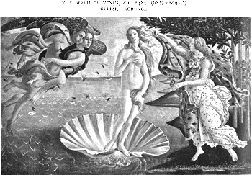 |
The votaries of Ishtar were in all cases virgins who, so long as they remained in her service, were not permitted to marry. This tradition is found also among the Roman Vestal Virgins and is recapitulated in the celibacy of Catholic priests and nuns instituted in 305ad by the Spanish synod of Elvira. Astarte (Ashtoreth) is the female counterpart of the Sun-god Baal worshiped by the Canaanite's and Phoenicians, and to the Dagon of the Philistines. She was a patroness of the hunt, and as such was inevitably later identified with Artemis. Her worship fused with that of Aphrodite, Artemis, Diana, Juno and Venus. Her star was the planet Venus, and classical writers gave her the epithet Caelestis and Urania. Lucian and Herodian testify that she was represented with horns, and the place-name Ashteroth-Karnaim in Gilead (Ashtoreth of the horns) is considered ample corroboration. The Minoan Great Mother of ancient Crete has as attributes the double axe and the bull. The shape of the double axe and the horns of the bull recall the crescent Venus. Her religious being survived in the worship of Aphrodite and Rhea.
Egyptian Isis

The Egyptian Isis (Ese) wore the horns of a cow, and the cow was sacred to her. Her cult was the most persistent in maintaining itself against Christianity, with which it had a great deal in common, both in doctrine and in emblems. Her worship declined after 307ad, though it persisted in Italy until the 5th century. Her last remaining shrine at Philae was closed in the middle of the 6th century.
Roman Isis

Isis is identified with Demeter by Herodotus. Demeter is the mother of Persephone, who is carried off by Hades to the underworld. Demeter is enraged at Zeus for permitting the abduction. "In her wrath, she makes the earth barren, so that mankind are threatened with destruction by famine, as she does not allow the fruit of the earth to spring up again until her daughter is allowed to spend two-thirds of the year with her." (Dictionary of Classical Antiquities p. 177) Like Aphrodite, she is associated with the water-god Poseidon. The cow is sacred to her, and among her attributes is the torch-a common attribute of other deities associated with Venus.{12} The Romans identified her with Ceres, who was commonly portrayed with a ram's horn in her left arm, filled with fruits and flowers.
Aphrodite is the counterpart of the Roman goddess Venus. Aphrodite asteria (starlike), was identified with Phosphor (Lucifer){13} the morning star as well as Hesper the evening star.{14} As Aphro-geneia (foam born) or Anadyomene (she who rises from the sea) she is much associated with the sea-she even had a son named Ichthys (fish), perhaps because celestial objects were thought to rise from the sea. In art she is often represented as rising naked (like Ishtar) from the sea, or from a bath. Part of the worship of the Minoan Great Mother survives in her epithet Ariadne, "the exceeding holy."
Aphrodite is connected with the lower world, and was looked on as one of its divinities. Just as Ishtar descends to the kingdom of Ilat the queen of the dead, to find the means of restoring her favorite Tammuz (Adon, Adonis) to life, so does Aphrodite. During her stay all animal and vegetable productivity ceases, to begin again with her return to earth-a clear indication of the conception of her as a goddess of fertility. This legend strikingly resembles that of Persephone. There is no logical reason to associate this legend with the Moon, and as far as I can determine, no such association was ever made; however, it fits Venus beautifully. Her most distinctive title, Urania, the Semitic "Queen of the Heavens," corroborates her association with the planet Venus.
Pallas (perhaps from pallaks "virgin") Athena (athela "not giving milk; unsuckled-this seemingly refers both to her virgin state as well as her extraordinary birth from the brow of Zeus) is associated with the storm cloud, the pure ether, the dawn and twilight. With Zeus and Apollo, she forms a triad which represents the embodiment of all divine power. Though usually represented in her manifestation as protector of cities, goddess of war, she is also portrayed as the pure virgin (Athena Lemnia). In Roman mythology she is Minerva, goddess of wisdom.
Diana
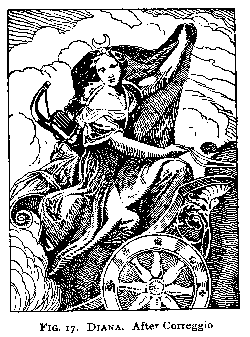
Artemis, the virgin huntress, is the counterpart of the Roman Diana. She is often portrayed as girt for the chase, and on her head she wears a crescent. My argument that this crescent does not represent the Moon, but rather Venus, is based both on the complete absence of early association of Artemis with the Moon, as well as the transference of the crescent from deities such as Aphrodite and the Cappadocian goddess Ma, another manifestation of Cybele associated with the planet Venus. Like the goddess Demeter one of her important attributes is the flaming torch.
"Another view of the original character of Artemis, which has found much support in modern times, is that she was a moon goddess. But there is no trace of Artemis as such in the epic period, and the Homeric hymn knows nothing of her identification with Selene." (Encyclopedia Britannica, eleventh edition, entry "Artemis" page 665)
Mexican Madonna on tin
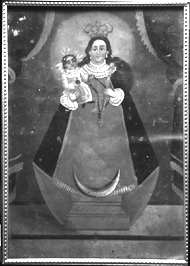
Though etymologically suspect, it is interesting that Saint Jerome suggests that the origin of the Hebrew name "Mary" was stella maris, "star of the sea." This early association of the Virgin not only with the morning star but with "foam born" deities, such as the Greek Aphrodite and Roman Venus, tends to confirm the carry-over of surviving Pagan religious practices and their grafting onto early Christianity.
Through the first three centuries of Christianity, Mary's perpetual virginity is nowhere mentioned. In 387 Jerome argued the case with much vehemence in his tract Against Helvidius, and by 451 the concept of parthenogenesis was adopted by the Council of Chalcedon.
Mary Queen of Heaven
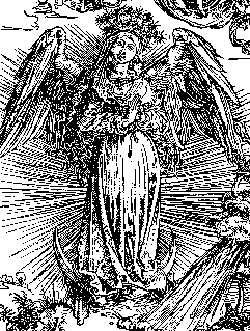
The appellation "Mother of God," an epithet formerly connected with the great nature-goddesses, was not applied to Mary before the close of the third century, though by the 4th century, it had become commonplace. From the time of the Council of Ephesus in 431, the cult of Mary had become an established aspect of orthodox Christianity. In adopting indiscriminately the panoply of Pagan nature-goddess, Mary Queen of Heaven (this epithet is identical to that of Aphrodite Urania) is also given the attribute of the crescent associated with her predecessors.{15}
This metamorphosis of Ishtar, Isis, Artemis etc. into the character of Mary coincides neatly with the idiological vacuum created by the triumph of the "pale Galilean."{16} Indeed, I would argue that at this juncture the Church Fathers, and in particular Saint Jerome, were all but consciously incorporating the Pagan female deities into the person of Mary the better to accommodate many of those who became professing Christians at the political eclipse of Paganism and who entered the Church with the instincts derived from the nature-religions in which they had been brought up fully developed. Saving the change in position of the crescent, modern artistic representations of Mary Queen of Heaven are indistinguishable from ancient representations of Ishtar.
Islamic Flags
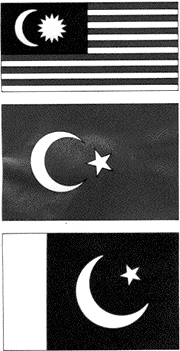
The crescent and star of Islamic nations may also be based on the planet Venus rather than the Moon. Bradley E. Schaefer of nasa-Goddard Space Flight Center, in the British weekly New Scientist, as reported in the February, 1992 Sky and Telescope handsomely disposes of all likely astronomical associations with the crescent Moon. Though he has found reference to the star and crescent throughout Persia, Italy, Romania and Yemen as far back as 2600bc, he confesses that none of them stands up to scrutiny if it is assumed that the symbol is a representation of the Moon and some other bright celestial object.
Isis

However, it may be that he has been looking for an explanation of these symbols in the wrong place. Having disposed pretty neatly of the moon as a candidate, we are left with the only other celestial object that presents a naked-eye crescent. If it is conjectured that the symbol of Islam is actually a graphic representation of the sun-disk-and-horns headdress of the ancient Mother Goddess, things begin to fall into place, especially when it is remembered that before the Prophet Mohammed (570ad) the Islamic peoples were polytheistic.
Just as one goddess absorbs, is absorbed by or changes into another, taking over her epithets and attributes whole-hog as cultures collide-cow's horns and crescent planets become one; rising stars turn into Ocean goddesses washed up by the sea in enormous eggs, tended by midwife doves to burst upon a wondering world as a paradigm of love-so do basic symbols change mistresses while retaining their basic natures. The ancient ankh-symbol of life, womankind and the planet Venus-becomes the Christian cross; the headdress of the Great Mother hides in plain sight on the flags of Islam.
Egg of Isis
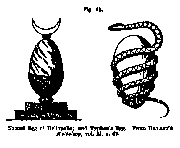
"An egg of wondrous size is said to have fallen from heaven into the river Euphrates. The fishes rolled it to the bank, where the doves having settled upon it, and hatched it, out came Venus, who afterwards was called the Syrian Goddess-that is, Astarte. Hence, the egg became one of the symbols of Astarte or Easter." (The Two Babylons, Alexander Hislop, page 109, quoting Hyginus' Fabulae pp. 148, 149) The Sacred Egg of Heliopolis looks like nothing so much as a minaret, and the crescent at its peak like nothing so much as a representation of the crescent Venus.{17}
Minaret
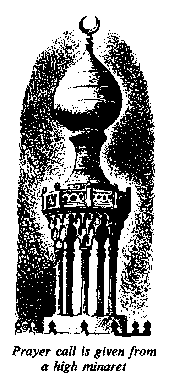
As the civilized peoples of the Tigris and Euphrates delta spread, they brought their religion with them and it is no surprise to find the symbols of Venus extant in Islamic countries today, both crescent and egg, though the ancient connection to the nature-worship that antedates Mohammed has been lost. In further support of this conjecture, it is interesting to note that the star accompanying the crescent is often said to be Venus.
The most important gods and goddesses of all Western polytheistic religions merge upon examination into only two, one male and one female. The male god represents the sun, and the female the planet Venus. She takes many forms: the Assyrian Ishtar, the Phoenician Ashtoreth (Astarte), the Syrian Atargatis (Dereto), the Egyptian Isis, the Babylonian Belit (Mylitta), the Arabian Ilat (Al-ilat), the Greek Aphrodite, the Roman Diana and the Roman Catholic Mary. It becomes plain that all the female manifestations of the deity-the horns of bulls and cows as attributes of Isis and Ishtar; the bull-dancing of Minoa; Diana and Artemis wearing a crescent on their brows; Mary Queen of Heaven standing on what appears to be the crescent Moon and so on-are not wearing, or standing on, or primarily associated with the Moon at all but rather the planet Venus.
In sum, I conclude that the ancients had, indeed, observed Venus as a crescent, that they employed this aspect of the planet's appearance as a distinctive attribute of the many facets of the one Goddess it represented, and that the evidence is plainly portrayed as a significant attribute of most, if not all, the major female deities.
References:
Astronomical Facts and Feats, Patrick Moore, Guinness Superlatives Ltd, London, 1979
Astronomy of the Ancients, Edited by Kenneth Brecher and Michael Feirtag, MIT Press, 1979
The Cambridge Encyclopedia of Astronomy, Editor-in-Chief Simon Mitton, Crown Publishers, New York, 1977
Celestial Objects for Common Telescopes, Volume One: The Solar System, The Reverend T.W. Webb, Longmans Green and Co, 1917
The Classic Myths in English Literature and in Art, Charles Mills Gayley, Ginn and Company, Boston, 1893
Dictionary of Classical Antiquities, Oskar Seyffert, World Publishing, Cleveland, 1961
Encyclopedia Britannica, eleventh edition, 1910 A Field Guide to the Stars and Planets, Donald H. Menzel, Houghton Mifflin, Boston, 1964
Oxford Classical Dictionary, Edited by M. Cary, et al, Oxford, at the Clarendon Press, 1949
Science and Civilisation in China, Joseph Needham, Cambridge University Press, 1954 -
Sky & Telescope magazine, February 1992, "Origin of the Star and Crescent," page 129
Sky & Telescope magazine, February 1992, cites my observation of the crescent Venus in "Observer's Notebook," page 231
Son of the Morning Star, Evan S. Connell, North Point Press, San Francisco, 1984
The Two Babylons, Alexander Hislop, Loizeaux Brothers, Neptune NJ, 1916
Illustrations:
The Virgin in Glory: Title Page to the Life of the Virgin, "The Virgin in Glory," Albrecht Dürer, Nuremberg, 1511. From The Complete Woodcuts of Albrecht Dürer, Edited by Dr. Willi Kurth, Dover, 1963, page 219
Egyptian Isis: Oskar Seyffert, Dictionary of Classical Antiquities, Meridian, 1956, page 325
Roman Isis: Oskar Seyffert, Dictionary of Classical Antiquities, Meridian, 1956, page 325
Aphrodite Rising from the Sea: "La Nascita di Venere," Sandro di Botticelli, Firenze, Uffizi
Diana: Charles Mills Gayley, Litt D, LLD, The Classic Myths in English Literature and in Art, Ginn and Company, 1893, page 29
Mary Queen of Heaven: "The Woman Clothed with the Sun, and the Seven-Headed Dragon" (detail), Albrecht Dčrer, Nuremberg, 1498. From The Complete Woodcuts of Albrecht Dčrer, Edited by Dr Willi Kurth, Dover, 1963, page 115
Islamic Flags: Sky & Telescope magazine, February 1992, page 129
Isis: The Winston Dictionary, The John C. Winston Co, 1946, page 522
Egg of Astarte: The Two Babylons, Alexander Hislop, Loizeaux Brothers, Neptune NJ, 1916, page 109
Minaret: Unknown
I wish to extend my thanks for valuable advice, research and editorial assistance to Dr. Karen Olsen Bruhns, Leila Chow, OD, Dave Dearborne, Lisa Goines, Wanda Burch Goines, Edie Sei Ichioka, Dr. David H. Kelley, Robert Mates, Dr. Robert A. Pfost, Luigi Semenzato and Thomas William Weller.
David Lance Goines
On May 5, 1995 I received a letter from Dr. Arnold Lebeuf of the University d'Varsovie, Poland. His interest was in getting from me a printout of occultations of Venus by the Moon at Piramide Xochicalco, Mexico, over the last 20 centuries. In this letter he made a number of interesting remarks about my thesis that pre-telescopic peoples had observed the crescent Venus.
1) The popular name of the planet in Provence, France, is "La Lunette," "The Little Moon." Reported in Paul Sebillot, Le Folklore de France.
2) Somewhere in Camille Flammarion's review "L'Astronomie," there are two verified19th century reports of observations of the moons of Jupiter. One by a Siberian hunter, and one by an Arab Beduin.
3) "Simple people are often marvellous observers, for example, the fishermen of Catalonia have built a whole legend on the variability of Algol (reported by Joan Amades, Costumari Catala)."
4) Dr. Lebeuf argues that, though the ancients did not have glass of a quality to make lenses, they did have rock crystal, and he believes that they may have made lenses with which they were able to observe the heavens. He cites Sir David Breswer and also Th. Henri Martin's "Sur des Instruments d'optique Faussement Attribues aux Anciens par Quelquers Savants Modernes," Rome, 1871.
5) Dr. Lebeuf argues that the Moon is of greater significance than I have accorded it, and the three main celestial objects have equal importance. The Greek Athena is fully lunar as well as is her Roman avatar, Minerva (Men: the Month, the Measure, the menstruation).
6) The Virgin Mary, though associated with the Moon in Christian tradition, is not associated with the planet Venus. "Whatever etymology St. Jerome gives to Mary, Miriam is rather connected to he Hebrew root MR of mirrors, which was well understood in Latin medieval litergy where she is called, "Speculum sine Macula," a spotless mirror. Still I recognize that the sign of Venus is the image of a mirror and the attribute pare excellence of the patron of prostitutes (sacred, of course, Kedesha: meaning both Saint and Prostitute). For Venus in Christianity, rather look in the direction of Maria Magdala.
"Venus, in the incarnation of Ishtar-Astarte-Aphrodite, is often pictured riding a bull, and she has been related as well to the horned altars of Knossos on Mycenaean Crete. Recall that in Babylonian mythology Ishtar is the daughter of Sin, the crescent-shaped moon god. Did keen-eyed observers in the clear air of Mesopotamia actually see the resemblance between father and daughter 3500 years before Gallileo detected it with the new telescope? Some quotations from the cuneiform literature are highly suggestive:
If on the right horn of Venus a star is visible you will have good crops in the land.
When upon the right horn of Venus a star is not visible the land will bear many misfortunes.{18}
If Ishtar takes away upon her right horn a star, and if Ishtar is large but the star small, the kind [people of the city] of Elam will be strong and mighty.{19}
The ancient Mexican codices may have described Venus as a stippled ball, sometimes accompanied by a pair of horns that give it a crescent shape. It is difficult to attribute all these associations to lucky guesses, especially when we find that they offer reasonable expressions of astronomical symbolism in different cultures. (Anthony Aveni, Conversing with the Planets, Times Books, New York, 1992, pages 187-188)
Dr Kelley Replies:
Lista de Correos Progreso, Yucatan, Mexico 14 Nov, 1991
Dear Mr. Goines,
I was very pleased to hear of your observation of crescent Venus. I know of no indisputable pre-telescopic reference to the Venus crescent. However, Mesopotamian mythology refers to 'horned Ishtar' and I have been inclined to think that this was a reference to Venus in its crescent phase, though I haven't ever said so, because I don't think it is clear enough to be more than suggestive.
Mexican Horned Venus
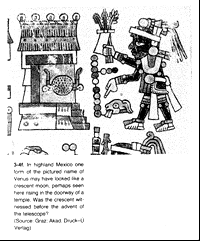
In Mesoamerica, I know of nothing which anyone has yet interpreted as a reference to the crescent phase. There is an additional complicating factor which would have increased the probability of seeing it, even though not recorded. Concave obsidian mirrors were in use in the area. Such a mirror can be used as a reflecting telescope and allow observation much closer to the sun, by holding it so that the sun's rays are just missed. Even a straight surface will substantially improve visibility. One can get a rough approximation with a shaving mirror, though it lacks the dark surface. The name of the god Tezcatlipoca, 'smoking mirror,' suggests that such mirrors may have started as fire-lighters, but that people holding them for such a purpose might have noticed astronomical things as well-Tezcatlipoca was supposed to be able to know everything happening with his mirror. It may be that closer knowledge and analysis in astronomical terms of the mythology may furnish clearer indications-statement of when Ishtar got her horns perhaps.
Gene Milone and I are preparing a general book on archaeoastronomy, and would appreciate permission to cite your observation.
With best wishes,
David H. Kelley
FOOTNOTES
{1} The Oakland, California, optometrist Dr. Robert A. Pfost informs me that the vernier acuity of the eye is typically 2 seconds of arc, that the resolving power of the eye of a person with 20-20 vision is typically 1 minute of arc, and that the resolving power of the eye when viewing an illuminated object is typically 15 to 20 seconds of arc. At the time, Earth's sister planet had an apparent diameter of 40 arc seconds. It extends to a maximum of 64.5 arc seconds. Even though the planet's phases should be seen easily, its glare severely inhibits resolution. If, for example, the brightness of Jupiter is occluded, its Galilean satellites are well within the range of naked-eye observation. Yet, there is no indication that they were ever seen before the telescope was invented in 1609. I thank Dave Dearborne for this observation.
Note on visual acuity provided by Leila Chow, OD, April 15, 1992: At your last office visit, you had inquired about the resolution of the human eye. There are three types of resolution of the eye and we discussed two of them. The following are the three types of observer tasks with their corresponding minimum angle of resolution (MAR):
1) Minimum Resolvable: This task has a MAR of 30 seconds to one minute of arc. One minute of arc resolution is equivalent to 20/20 vision.
2) Minimum Discriminable: This type of resolution has a MAR of 2 to 10 seconds of arc. This is also known as hyperacuities. Vernier acuity and stereoacuity are examples of hyperacuities.
3) Minimum Detectable: The MAR for this task is one second of arc. This task is not an acuity task; rather, it is a contrast detection task. Your ability to detect the planet Venus at sunrise is an example of a minimum detectable task.
{2} As I was recounting this experience to my friend Robert Mates, of Berkeley, California, he told me that he too had once seen Venus as a crescent at sunset, and that he had confirmed the sighting with binoculars. Mr Mates is Caucasian, 50 years old and requires no vision correction.
The Reverend T.W. Webb, in his Celestial Objects for Common Telescopes, Volume One: The Solar System, Longmans Green and Co, 1917, reports on page 63 that: "This crescent has been seen even with the naked eye in the sky of Chile, and with a dark glass in Persia, and a very small telescope will show it. . . . Theodore Parker saw it in America when 12 years old, and ignorant of its existence, and when no one else could perceive it."
{3} 3 The effects of this eruption are discussed in the December, 1991 Sky and Telescope, pp 677-681.
{4} 4 "The Babylonian computers were not only aware that Venus returns in almost exactly eight years to a given starting point in the sky, but they had established similar periodic relations in 46, 59, 79 and 83 years severally for Mercury, Saturn, Mars and Jupiter." (Encyclopædia Britannica, eleventh edition, article "Astronomy" page 809)
"Farewell Morning Star, herald of dawn, and quickly come as the Evening Star, bringing again in secret her whom thou takest away. -Meleager, First century bc. (The Greek Anthology (1906), J. W. Mackail, editor, sect. 1, no. 21
The Greeks understood the cause and nature of the crescent phase of the Moon, and "Heraclides, who became a disciple of Plato in 360BC taught that the Sun, while circulating around the earth, was the center of revolution to Venus and Mercury." (Encyclopædia Britannica, 11th edition, article "Astronomy," p 809) The crescent phases of Mercury and Venus could have been predicted from Heraclides' theory. though there is no evidence that they were. Indeed, Heraclides' heliocentric theories did not catch on.
{5} 5 That old gossip Herodotus (c. 484-425 BC), for example, who babbled on at interminable length about everything he had ever heard, seen or read says nothing at all on the subject.
Joseph Needham, in his exhaustive work on Chinese culture, Science and Civilisation in China, Cambridge University Press, 1954 -, similarly says nothing. This is all the more surprising since the ancient Chinese saw sunspots.
{6} 6 Of course, just because they could have seen it doesn't mean they did see it, though that is precisely what I am arguing. Cultural blind spots prevent people from seeing things that are perfectly obvious in other cultures. Furthermore, even within a culture that is capable of perceiving something, individuals usually cannot see things until they are educated to them. The Inca understood that the angle of the sun and position of the stars changed with different latitudes, but did not draw from this the conclusion that the earth was round. They weren't interested in the shape of the earth: as far as they were concerned, the earth was a vertical plane, and questions of its shape evidently did not enter their heads. ( This observation is the result of a telephone conversation on January 7, 1992, with Dave Dearborne of Lawrence Livermore Laboratory, University of California, Berkeley.)
"M51 is the 'nebula' that Ireland's Lord Rosse first noted as having a spiral pattern. The discovery was made with his 72-inch speculum-metal reflector in 1845. This revelation sparked much discussion in the astronomical community, but it was another three-quarters of a century before astronomers accepted the spiral nebula as a collection of stellar systems outside our own.
"The great English observer William Herschel had missed the spiral structure. I suspect part of the reason was that his eye had become 'trained' to see circles. Indeed, his drawings of M51 show the outer portion of the galaxy as a ring of light crossed by a single arc.
"Today's observers approach a telescope eyepiece knowing that M51's spiral structure exists. As is always the case, a feature can be seen in a much smaller telescope than was needed for its discovery. Indeed, M51's spiral arms can be readily seen in an 8-inch scope and are unmistakable in a 12-inch. Experienced observers under good skies have reported the spiral pattern with 6-inch apertures, and some, including me, have even glimpsed it with a 4-inch." (Walter Scott Houston, writing an article "Three Messier Galaxies," for "Deep Sky Wonders," in Sky and Telescope, June 1993, page 106)
{7} 7 The Emperor Napoleon specifically mentions just such a sighting, when the daytime brilliance of Venus drew the attention of a crowd away from his own celestial presence.
{8} 8 The no doubt pre-historic observation that Venus is apparently the consort of the Ruler of the Day may be of some significance; as "the bright and morning star" (Revelations 22:16) the planet heralds the Sun and as the evening star she faithfully follows his chariot into the twilight, approaching closer in some seasons, in others drawing away.
"Evening star, you bring all things which the bright dawn has scattered: you bring the sheep, you bring the goat, you bring the child back to its mother." Sappho,c 612 bc fragment 120
{9} 9 This favorably compares to the drier scientific account of the cycle: "At its position of greatest elongation Venus appears 48ű away from the Sun in the sky. The planet is best placed for visual observations from the Earth when it is near these positions. During its orbital motion Venus turns varying parts of its illuminated hemisphere toward the Earth so that it shows phases similar to the Moon. At inferior conjunction the dark side is toward Earth, but, as Venus moves, the illuminated hemisphere is gradually turned towards earth: at greatest western elongation half the visible hemisphere is illuminated and at superior conjunction all of it is. In the other half of the orbit the phases occur in the reverse order. Meanwhile the apparent diameter of Venus is varying between 64.5 arc sec at inferior conjunction, when it is nearest to Earth, and 9.9 arc sec at superior conjunction when it is furthest away. Because of its varying phase and distance Venus does not attain its brightest apparent magnitude at either conjunction, but near to its positions of great elongation." The Cambridge Encyclopædia of Astronomy, Editor-in-Chief Simon Mitton, Crown Publishers, New York, 1977 p 163.
{10} 10 The intervals are: Morning Star, 236 days, Evening Star, 250 days; disappearance behind and in front of the sun, 90 days and eight days, respectively. The whole cycle is 584 days. Data obtained from Astronomy of the Ancients, Edited by Kenneth Brecher and Michael Feirtag, MIT Press, 1979, pp 84-85.
{11} I have Dr Kelley to thank for the "Horned Ishtar" reference. It no doubt also refers to actual animal horns, as well as to the horns of the crescent Venus. The horns of Isis, for example, are clearly the horns of cattle. I thank Dr Bruhns for the information that Neolithic burial sites are often associated with the horns of animals. Though there may be some undiscoverable religious significance to these funerary horns, their original purpose may have been no more than digging tools, and the horns, once so employed, may have been left with the interred for reasons of respect or tabu. When considering pre-bronze age funeral rites, the difficulty of digging an adequate grave without modern tools should not be underestimated.
{12} When rising, Venus often does look torch-like. At its brightest, Venus shines at magnitude -4.3. After the Sun (-26.7) and the Moon (-12.5) it is the brightest object in the heavens. In modern times, people often report the planet as a UFO (in addition to being attacked by an aquatic rabbit, President Jimmy Carter did just that during his term of office). The following account of the rising Venus is given by members of General George Armstrong Custer's Seventh Cavalry as they waited for dawn along the Washita to attack a Cheyenne encampment:
"And suddenly the morning star emerged from the ground fog, rising with such brilliance that at first the astonished men mistook it for a rocket. How they could mistake a planet for a rocket is hard to understand, if only because one does not associate Indians with rockets. Nevertheless, they did. "However this misapprehension should be explained, Custer's men and the commandant himself were stupefied: 'Slowly and majestically it continued to rise above the crest of the hill, first appearing as a small brilliant flaming globe of bright golden hue. As it ascended still higher it seemed to increase in size, to move more slowly, while its colors rapidly changed from one to the other, exhibiting in turn the most beautiful combinations of prismatic tints. There seemed not to be the shadow of a doubt that we were discovered.'" Evan S. Connell, Son of the Morning Star, North Point Press, San Francisco, 1984, pp 182-183
{13} ". . . the angel Lucifer, whom Spenser called 'the brightest angel, even the child of Light.' But most readers will recall Lucifer from Paradise Lost as Milton's demon of sinful pride (hubris). Milton derived his pejorative casting from St. Jerome, who misread a phrase in Isaiah and applied the name 'Lucifer' to Satan, the adversary. But Isaiah 14:12 merely exclaims, 'How art thou fallen from Heaven, O Lucifer, son of the morning' an apostrophe to Nebuchadnezzar, who later ate grass." William B. Ober, MD, Bottoms Up!, Southern Illinois University Press, 1987, page 221.
{14} The apparent motion of Venus may be described as an oscillation from one side of the Sun to the other, the complete period of which is 1.6 years, and the greatest elongation about 45ű on each side of the Sun. When east of the latter it appears as the "evening star" in the west after sunset, while near western elongation it is seen as the "morning star" before sunrise. (Encyclopædia Britannica, eleventh edition, article Venus, page 1013)
{15} Mary stands on, or is superior to the crescent, whereas Ishtar wore the crescent above her head or on her brow. The relevant passage is in the Book of Revelations of Saint John the Divine, chapter 12, verse 1, "And there appeared a great wonder in heaven; a woman clothed with the sun, and the moon under her feet, and upon her head a crown of twelve stars:" This image finds its best expression in the New World Virgin of Guadalupe.
{16} "Thou has conquered, O pale Galilean;
the world has grown gray from thy breath;" Algernon Charles Swinburne (1837-1909), Hymn to Proserpine: After the Proclamation in Rome of the Christian Faith
{17} In passing, the characteristic Russian "onion domes" may also be after the same pattern. The 14th-century Tartar warlord Tamerlane, whose armies ravaged Asia from Syria and Turkey to the edges of China, and from Moscow to Delhi, is reputed to have preserved and introduced the style to Russia, thence to India. The remnants of his Samarkand tomb are topped by a dome that may have been an imitation of the one atop the central mosque in Damascus, which he sacked in 1401. The style may have spread to India via his descendant, Baber, who overthrew the Sultan of Delhi in 1526 and founded the Mogul Empire. The emperor Shah Jahan built the Taj Mahal in 1648, the central aspect of which is just such a dome.
{18} J. Offord, "The Deity of Crescent Venus in Ancient Western Asia," 197.
{19} Bezond, quoted. in ibid., 197.
|
|||||||||||||||
| Previous Article | This Article | |
Return to S - Z Index |